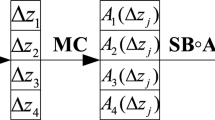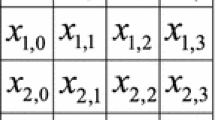Abstract
Impossible differential cryptanalysis is a powerful cryptanalysis technique of block ciphers. Length of impossible differentials is important for the security evaluation of a block cipher against impossible differential cryptanalysis. Many previous studies on finding impossible differentials of AES assumed that round keys are independent and uniformly random. There are few results on security evaluation of AES in the master-key setting. In ASIACRYPT 2020, Hu et al. redefined impossible differential with the key schedule considered, and showed that there exists no one-byte active input and one-byte active output impossible differential for 5-round AES-128 even considering the relations of 3-round keys. In this paper, we prove theoretically that even though the relations of all round keys are considered, there do not exist three kinds of truncated impossible differentials for 5-round AES: (1) the input truncated differences are nonzero only in any diagonal and the output truncated differences are nonzero only in any inverse diagonal; (2) the input truncated differences are nonzero only in any two diagonals and the output truncated differences are nonzero only in any inverse diagonal; (3) the input truncated differences are nonzero only in any diagonal and the output truncated differences are nonzero only in any two inverse diagonals. Furthermore, for any given truncated differentials of these three kinds, the lower bounds of the number of master keys such that the truncated differentials are possible for 5-round AES-128 are presented.
Access this chapter
Tax calculation will be finalised at checkout
Purchases are for personal use only
Similar content being viewed by others
References
Bahrak, B., Aref, M.R.: Impossible differential attack on seven-round AES-128. IET Inf. Secur. 2(2), 28–32 (2008)
Bar-On, A., Dunkelman, O., Keller, N., Ronen, E., Shamir, A.: Improved key recovery attacks on reduced-round AES with practical data and memory complexities. J. Cryptol. 33(3), 1003–1043 (2020)
Bardeh, N.G., Rønjom, S.: The exchange attack: how to distinguish six rounds of AES with \(2^{88.2}\)chosen plaintexts. In: Galbraith, S.D., Moriai, S. (eds.) ASIACRYPT 2019. LNCS, vol. 11923, pp. 347–370. Springer, Cham (2019). https://doi.org/10.1007/978-3-030-34618-8_12
Biham, E., Biryukov, A., Shamir, A.: Cryptanalysis of Skipjack reduced to 31 rounds using impossible differentials. In: Stern, J. (ed.) EUROCRYPT 1999. LNCS, vol. 1592, pp. 12–23. Springer, Heidelberg (1999). https://doi.org/10.1007/3-540-48910-X_2
Biham, E., Keller, N.: Cryptanalysis of reduced variants of Rijndael. In: The 3rd AES Conference (2000)
Boura, C., Lallemand, V., Naya-Plasencia, M., Suder, V.: Making the impossible possible. J. Cryptol. 31(1), 101–133 (2018)
Boura, C., Naya-Plasencia, M., Suder, V.: Scrutinizing and improving impossible differential attacks: applications to CLEFIA, Camellia, LBlock and Simon. In: Sarkar, P., Iwata, T. (eds.) ASIACRYPT 2014. LNCS, vol. 8873, pp. 179–199. Springer, Heidelberg (2014). https://doi.org/10.1007/978-3-662-45611-8_10
Chen, J., Wang, M., Preneel, B.: Impossible differential cryptanalysis of the lightweight block ciphers TEA, XTEA and HIGHT. In: Mitrokotsa, A., Vaudenay, S. (eds.) AFRICACRYPT 2012. LNCS, vol. 7374, pp. 117–137. Springer, Heidelberg (2012). https://doi.org/10.1007/978-3-642-31410-0_8
Cheon, J.H., Kim, M.J., Kim, K., Jung-Yeun, L., Kang, S.W.: Improved impossible differential cryptanalysis of Rijndael and Crypton. In: Kim, K. (ed.) ICISC 2001. LNCS, vol. 2288, pp. 39–49. Springer, Heidelberg (2002). https://doi.org/10.1007/3-540-45861-1_4
Derbez, P., Fouque, P.-A., Jean, J.: Improved key recovery attacks on reduced-round AES in the single-key setting. In: Johansson, T., Nguyen, P.Q. (eds.) EUROCRYPT 2013. LNCS, vol. 7881, pp. 371–387. Springer, Heidelberg (2013). https://doi.org/10.1007/978-3-642-38348-9_23
Dunkelman, O., Keller, N., Ronen, E., Shamir, A.: The retracing boomerang attack. In: Canteaut, A., Ishai, Y. (eds.) EUROCRYPT 2020. LNCS, vol. 12105, pp. 280–309. Springer, Cham (2020). https://doi.org/10.1007/978-3-030-45721-1_11
Ferguson, N., et al.: Improved cryptanalysis of Rijndael. In: Goos, G., Hartmanis, J., van Leeuwen, J., Schneier, B. (eds.) FSE 2000. LNCS, vol. 1978, pp. 213–230. Springer, Heidelberg (2001). https://doi.org/10.1007/3-540-44706-7_15
Leurent, G., Pernot, C.: New representations of the AES key schedule. In: Canteaut, A., Standaert, F.-X. (eds.) EUROCRYPT 2021. LNCS, vol. 12696, pp. 54–84. Springer, Cham (2021). https://doi.org/10.1007/978-3-030-77870-5_3
Grassi, L.: Mixture differential cryptanalysis: New approaches for distinguishers and attacks on round-reduced AES. IACR Trans. Symmetric Cryptol. 2018(2), 133–160 (2018)
Grassi, L., Rechberger, C., Rønjom, S.: Subspace trail cryptanalysis and its applications to AES. IACR Trans. Symmetric Cryptol. 2016(2), 192–225 (2016)
Grassi, L., Rechberger, C., Rønjom, S.: A new structural-differential property of 5-round AES. In: Coron, J.-S., Nielsen, J.B. (eds.) EUROCRYPT 2017. LNCS, vol. 10211, pp. 289–317. Springer, Cham (2017). https://doi.org/10.1007/978-3-319-56614-6_10
Hu, K., Cui, T., Gao, C., Wang, M.: Towards key-dependent integral and impossible differential distinguishers on 5-round AES. In: Cid, C., Jacobson, M., Jr. (eds.) SAC 2018. LNCS, vol. 11349, pp. 139–162. Springer, Cham (2019). https://doi.org/10.1007/978-3-030-10970-7_7
Hu, X., Li, Y., Jiao, L., Tian, S., Wang, M.: Mind the propagation of states. In: Moriai, S., Wang, H. (eds.) ASIACRYPT 2020. LNCS, vol. 12491, pp. 415–445. Springer, Cham (2020). https://doi.org/10.1007/978-3-030-64837-4_14
Kanda, M., Matsumoto, T.: Security of camellia against truncated differential cryptanalysis. In: Matsui, M. (ed.) FSE 2001. LNCS, vol. 2355, pp. 286–299. Springer, Heidelberg (2002). https://doi.org/10.1007/3-540-45473-X_24
Knudsen, L.R.: DEAL - a 128-bit cipher. Technical report, Department of Informatics, University of Bergen, Norway (1998)
Mala, H., Dakhilalian, M., Rijmen, V., Modarres-Hashemi, M.: Improved impossible differential cryptanalysis of 7-round AES-128. In: Gong, G., Gupta, K.C. (eds.) INDOCRYPT 2010. LNCS, vol. 6498, pp. 282–291. Springer, Heidelberg (2010). https://doi.org/10.1007/978-3-642-17401-8_20
Rønjom, S., Bardeh, N.G., Helleseth, T.: Yoyo tricks with AES. In: Takagi, T., Peyrin, T. (eds.) ASIACRYPT 2017. LNCS, vol. 10624, pp. 217–243. Springer, Cham (2017). https://doi.org/10.1007/978-3-319-70694-8_8
Sun, B., Liu, M., Guo, J., Qu, L., Rijmen, V.: New insights on AES-Like SPN ciphers. In: Robshaw, M., Katz, J. (eds.) CRYPTO 2016. LNCS, vol. 9814, pp. 605–624. Springer, Heidelberg (2016). https://doi.org/10.1007/978-3-662-53018-4_22
Sun, B., Liu, M., Guo, J., Rijmen, V., Li, R.: Provable security evaluation of structures against impossible differential and zero correlation linear cryptanalysis. In: Fischlin, M., Coron, J.-S. (eds.) EUROCRYPT 2016. LNCS, vol. 9665, pp. 196–213. Springer, Heidelberg (2016). https://doi.org/10.1007/978-3-662-49890-3_8
Tsunoo, Y., Tsujihara, E., Shigeri, M., Saito, T., Suzaki, T., Kubo, H.: Impossible differential cryptanalysis of CLEFIA. In: Nyberg, K. (ed.) FSE 2008. LNCS, vol. 5086, pp. 398–411. Springer, Heidelberg (2008). https://doi.org/10.1007/978-3-540-71039-4_25
Wang, Q., Jin, C.: Upper bound of the length of truncated impossible differentials for AES. Des. Codes Crypt. 86(7), 1541–1552 (2017). https://doi.org/10.1007/s10623-017-0411-z
Wang, Q., Jin, C.: More accurate results on the provable security of AES against impossible differential cryptanalysis. Des. Codes Crypt. 87(12), 3001–3018 (2019). https://doi.org/10.1007/s10623-019-00660-7
Zhang, W., Wu, W., Feng, D.: New results on impossible differential cryptanalysis of reduced AES. In: Nam, K.-H., Rhee, G. (eds.) ICISC 2007. LNCS, vol. 4817, pp. 239–250. Springer, Heidelberg (2007). https://doi.org/10.1007/978-3-540-76788-6_19
Acknowledgements
The authors are grateful to the anonymous reviewers for their helpful comments and suggestions. This work was supported by the National Cryptography Development Fund of China under grant numbers MMJJ20170103 and MMJJ20180204.
Author information
Authors and Affiliations
Editor information
Editors and Affiliations
Rights and permissions
Copyright information
© 2021 Springer Nature Switzerland AG
About this paper
Cite this paper
Yan, X., Tan, L., Xu, H., Qi, W. (2021). On the Provable Security Against Truncated Impossible Differential Cryptanalysis for AES in the Master-Key Setting. In: Yu, Y., Yung, M. (eds) Information Security and Cryptology. Inscrypt 2021. Lecture Notes in Computer Science(), vol 13007. Springer, Cham. https://doi.org/10.1007/978-3-030-88323-2_21
Download citation
DOI: https://doi.org/10.1007/978-3-030-88323-2_21
Published:
Publisher Name: Springer, Cham
Print ISBN: 978-3-030-88322-5
Online ISBN: 978-3-030-88323-2
eBook Packages: Computer ScienceComputer Science (R0)




